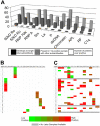60 kD Ro and nRNP A frequently initiate human lupus autoimmunity
- PMID: 20224770
- PMCID: PMC2835743
- DOI: 10.1371/journal.pone.0009599
60 kD Ro and nRNP A frequently initiate human lupus autoimmunity
Abstract
Systemic lupus erythematosus (SLE) is a clinically heterogeneous, humoral autoimmune disorder. The unifying feature among SLE patients is the production of large quantities of autoantibodies. Serum samples from 129 patients collected before the onset of SLE and while in the United States military were evaluated for early pre-clinical serologic events. The first available positive serum sample frequently already contained multiple autoantibody specificities (65%). However, in 34 SLE patients the earliest pre-clinical serum sample positive for any detectable common autoantibody bound only a single autoantigen, most commonly 60 kD Ro (29%), nRNP A (24%), anti-phospholipids (18%) or rheumatoid factor (15%). We identified several recurrent patterns of autoantibody onset using these pre-diagnostic samples. In the serum samples available, anti-nRNP A appeared before or simultaneously with anti-nRNP 70 K in 96% of the patients who had both autoantibodies at diagnosis. Anti-60 kD Ro antibodies appeared before or simultaneously with anti-La (98%) or anti-52 kD Ro (95%). The autoantibody response in SLE patients begins simply, often binding a single specific autoantigen years before disease onset, followed by epitope spreading to additional autoantigenic specificities that are accrued in recurring patterns.
Conflict of interest statement
Figures




Similar articles
-
Modification of lupus-associated 60-kDa Ro protein with the lipid oxidation product 4-hydroxy-2-nonenal increases antigenicity and facilitates epitope spreading.Free Radic Biol Med. 2005 Mar 15;38(6):719-28. doi: 10.1016/j.freeradbiomed.2004.11.001. Free Radic Biol Med. 2005. PMID: 15721982
-
Selective small antigenic structures are capable of inducing widespread autoimmunity which closely mimics the humoral fine specificity of human SLE.Scand J Immunol. 2002 Oct;56(4):399-407. doi: 10.1046/j.1365-3083.2002.01141.x. Scand J Immunol. 2002. PMID: 12234261
-
Fine specificity of the autoimmune response to the Ro/SSA and La/SSB ribonucleoproteins.Arthritis Rheum. 1999 Feb;42(2):199-209. doi: 10.1002/1529-0131(199902)42:2<199::AID-ANR1>3.0.CO;2-1. Arthritis Rheum. 1999. PMID: 10025913 Review.
-
A limited lupus anti-spliceosomal response targets a cross-reactive, proline-rich motif.J Autoimmun. 1998 Oct;11(5):431-8. doi: 10.1006/jaut.1998.0227. J Autoimmun. 1998. PMID: 9802926
-
The molecular basis of the SSA/Ro antigens and the clinical significance of their autoantibodies.Br J Rheumatol. 1993 May;32(5):396-402. doi: 10.1093/rheumatology/32.5.396. Br J Rheumatol. 1993. PMID: 8495261 Review.
Cited by
-
Smoking is not associated with autoantibody production in systemic lupus erythematosus patients, unaffected first-degree relatives, nor healthy controls.Lupus. 2014 Apr;23(4):360-9. doi: 10.1177/0961203314520838. Epub 2014 Jan 21. Lupus. 2014. PMID: 24449338 Free PMC article.
-
Innate and humoral recognition of the products of cell death: differential antigenicity and immunogenicity in lupus.Clin Exp Immunol. 2017 Mar;187(3):353-368. doi: 10.1111/cei.12889. Epub 2016 Dec 5. Clin Exp Immunol. 2017. PMID: 27783388 Free PMC article.
-
Triggers of Autoimmunity: The Role of Bacterial Infections in the Extracellular Exposure of Lupus Nuclear Autoantigens.Front Immunol. 2019 Nov 8;10:2608. doi: 10.3389/fimmu.2019.02608. eCollection 2019. Front Immunol. 2019. PMID: 31781110 Free PMC article. Review.
-
Intestinal Microbes in Autoimmune and Inflammatory Disease.Front Immunol. 2020 Dec 23;11:597966. doi: 10.3389/fimmu.2020.597966. eCollection 2020. Front Immunol. 2020. PMID: 33424846 Free PMC article. Review.
-
Description and utilization of the United States department of defense serum repository: a review of published studies, 1985-2012.PLoS One. 2015 Feb 27;10(2):e0114857. doi: 10.1371/journal.pone.0114857. eCollection 2015. PLoS One. 2015. PMID: 25723497 Free PMC article. Review.
References
-
- Maddison PJ, Reichlin M. Quantitation of precipitating antibodies to certain soluble nuclear antigens in systemic lupus erythematosus. Their contribution to hypergamma-globulinemia. Arthritis Rheum. 1997;20:819–825. - PubMed
-
- Hahn BH. Antibodies to DNA. NEJM. 1998;338:1359–68. - PubMed
-
- Tan EM, Cohen AS, Fries JF, Masi AT, McShane DJ, et al. The 1982 revised criteria for the classification of systemic lupus erythematosus. Arthritis Rheum. 1982;25:1271–7. - PubMed
-
- Hochberg MC. Updating the American College of Rheumatology revised criteria for the classification of systemic lupus erythematosus. Arthritis Rheum. 1997;40:1725. - PubMed
-
- Reichlin M, Wolfson-Reichlin M. Correlations of anti-dsDNA and anti-ribosomal P autoantibodies with lupus nephritis. Clin Immunol. 2003;108:69–72. - PubMed
Publication types
MeSH terms
Substances
Grants and funding
- AR49084/AR/NIAMS NIH HHS/United States
- AI31584/AI/NIAID NIH HHS/United States
- P20 RR020143/RR/NCRR NIH HHS/United States
- P30 GM103510/GM/NIGMS NIH HHS/United States
- RR15577/RR/NCRR NIH HHS/United States
- AI50350/AI/NIAID NIH HHS/United States
- AR45084/AR/NIAMS NIH HHS/United States
- P30 AR053483/AR/NIAMS NIH HHS/United States
- RR20143/RR/NCRR NIH HHS/United States
- R01 AI031584/AI/NIAID NIH HHS/United States
- AI62629/AI/NIAID NIH HHS/United States
- P20 RR015577/RR/NCRR NIH HHS/United States
- P30 RR031152/RR/NCRR NIH HHS/United States
- U19 AI062629/AI/NIAID NIH HHS/United States
- R37 AI024717/AI/NIAID NIH HHS/United States
- R01 AI024717/AI/NIAID NIH HHS/United States
- R01 AR048045/AR/NIAMS NIH HHS/United States
- AR48045/AR/NIAMS NIH HHS/United States
- P50 AR048940/AR/NIAMS NIH HHS/United States
- R01 AR045451/AR/NIAMS NIH HHS/United States
- T32 AI007633/AI/NIAID NIH HHS/United States
- AR48940/AR/NIAMS NIH HHS/United States
- P01 AR049084/AR/NIAMS NIH HHS/United States
- AR45451/AR/NIAMS NIH HHS/United States
LinkOut - more resources
Full Text Sources
Medical
Research Materials

